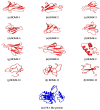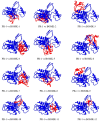PR-1-Like Protein as a Potential Target for the Identification of Fusarium oxysporum: An In Silico Approach
- PMID: 35822818
- PMCID: PMC9245465
- DOI: 10.3390/biotech10020008
PR-1-Like Protein as a Potential Target for the Identification of Fusarium oxysporum: An In Silico Approach
Abstract
Fusarium oxysporum remains one of the leading causes of economic losses and poor crop yields; its detection is strained due to its presentation in various morphological and physiological forms. This research work sought to identify novel biomarkers for the detection of Fusarium oxysporum using in silico approaches. Experimentally validated anti-Fusarium oxysporum antimicrobial peptides (AMPs) were used to construct a profile against Fusarium oxysporum. The performance and physicochemical parameters of these peptides were predicted. The gene for the Fusarium oxysporum receptor protein PR-1-like Protein, Fpr1, was identified and translated. The resulting protein model from the translation was then validated. The anti-Fusarium oxysporum AMPs and Fusarium oxysporum receptor protein 3-D structures were characterized, and their docking interaction analyses were carried out. The HMMER in silico tool identified novel anti-Fusarium oxysporum antimicrobial peptides with good performance in terms of accuracy, sensitivity, and specificity. These AMPs also displayed good physicochemical properties and bound with greater affinity to Fusarium oxysporum protein receptor PR-1-like Protein. The tendency of these AMPs to precisely detect Fusarium oxysporum PR-1-like Protein, Fpr1, would justify their use for the identification of the fungus. This study would enhance and facilitate the identification of Fusarium oxysporum to reduce problems associated with poor crop yield, economic losses, and decreased nutritional values of plants to keep up with the growing population.
Keywords: algorithms; antimicrobial peptides; fungal; pesticides; proteins; receptors; resistance.
Conflict of interest statement
The authors declare that there is no conflict of interest whatsoever.
Figures




Similar articles
-
In silico discovery of biomarkers for the accurate and sensitive detection of Fusarium solani.Front Bioinform. 2022 Sep 30;2:972529. doi: 10.3389/fbinf.2022.972529. eCollection 2022. Front Bioinform. 2022. PMID: 36304265 Free PMC article.
-
Analytical Studies of Antimicrobial Peptides as Diagnostic Biomarkers for the Detection of Bacterial and Viral Pneumonia.Bioengineering (Basel). 2022 Jul 11;9(7):305. doi: 10.3390/bioengineering9070305. Bioengineering (Basel). 2022. PMID: 35877356 Free PMC article.
-
Identification of biomarkers for the accurate and sensitive diagnosis of three bacterial pneumonia pathogens using in silico approaches.BMC Mol Cell Biol. 2020 Nov 20;21(1):82. doi: 10.1186/s12860-020-00328-4. BMC Mol Cell Biol. 2020. PMID: 33218302 Free PMC article.
-
Plant defense response against Fusarium oxysporum and strategies to develop tolerant genotypes in banana.Planta. 2014 Apr;239(4):735-51. doi: 10.1007/s00425-013-2024-8. Epub 2014 Jan 14. Planta. 2014. PMID: 24420701 Review.
-
Protective effects of hepatic diseases by bioactive phytochemicals in Fusarium oxysporum - A review.Heliyon. 2024 Feb 20;10(5):e26562. doi: 10.1016/j.heliyon.2024.e26562. eCollection 2024 Mar 15. Heliyon. 2024. PMID: 38455549 Free PMC article. Review.
Cited by
-
In silico discovery of biomarkers for the accurate and sensitive detection of Fusarium solani.Front Bioinform. 2022 Sep 30;2:972529. doi: 10.3389/fbinf.2022.972529. eCollection 2022. Front Bioinform. 2022. PMID: 36304265 Free PMC article.
-
Building HMM and molecular docking analysis for the sensitive detection of anti-viral pneumonia antimicrobial peptides (AMPs).Sci Rep. 2021 Oct 18;11(1):20621. doi: 10.1038/s41598-021-00223-8. Sci Rep. 2021. PMID: 34663864 Free PMC article.
-
Analytical Studies of Antimicrobial Peptides as Diagnostic Biomarkers for the Detection of Bacterial and Viral Pneumonia.Bioengineering (Basel). 2022 Jul 11;9(7):305. doi: 10.3390/bioengineering9070305. Bioengineering (Basel). 2022. PMID: 35877356 Free PMC article.
References
-
- Koike S.T., Gordon T.R. Management of Fusarium wilt of strawberry. Crop. Prot. 2015;73:67–72. doi: 10.1016/j.cropro.2015.02.003. - DOI
-
- Ploetz R.C., Herbert J., Sebasigari K., Hernandez J.H., Pegg K.G., Ventura J.A., Mayato L.S. Importance of Fusarium Wilt in Different Banana Growing Regions. APS Press; St. Paul, MN, USA: 1990. pp. 9–26.
-
- Jacobson D., Gordon T. Fusarium oxysporum f. sp. melonis: A case study of diversity within a forma specialis. Phytopathologyogy. 1991;81:1064–1067.
Grants and funding
LinkOut - more resources
Full Text Sources
Research Materials
